Southern Cross University: Agroforestry Farm Plan for Campbell Pocket
VerifiedAdded on 2022/10/01
|19
|3130
|248
Project
AI Summary
This agroforestry farm plan analyzes the Campbell Pocket property in South East Queensland, focusing on integrating native trees with commercial banana farming. The plan includes a detailed species description of banana and Eucalyptus tereticornis, along with an analysis of the soil and ground environment, recommending appropriate species for the site. It addresses bushfire hazards and overland flows, proposing solutions like fire trails and water harvesting. The plan outlines establishment procedures, silvicultural regimes, and management objectives, including carbon budgets. Furthermore, it provides an analysis of tax law, structural impediments, planning requirements, and a financial model for the farm. The plan emphasizes sustainable practices, aiming for a resilient and diverse farm system that generates multiple income sources. The document provides a comprehensive approach to agroforestry, offering practical solutions for land management and financial viability.
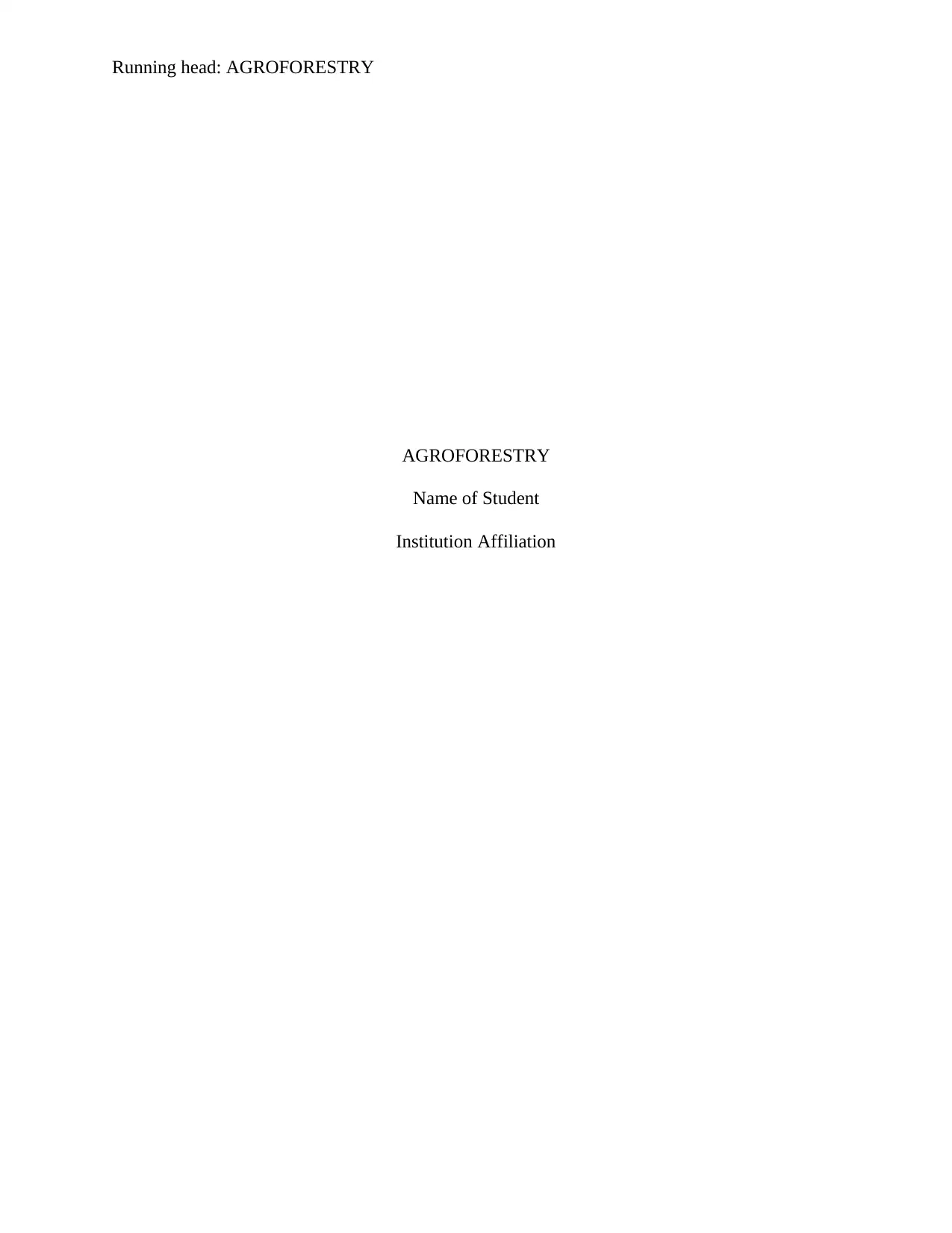
Running head: AGROFORESTRY
AGROFORESTRY
Name of Student
Institution Affiliation
AGROFORESTRY
Name of Student
Institution Affiliation
Paraphrase This Document
Need a fresh take? Get an instant paraphrase of this document with our AI Paraphraser
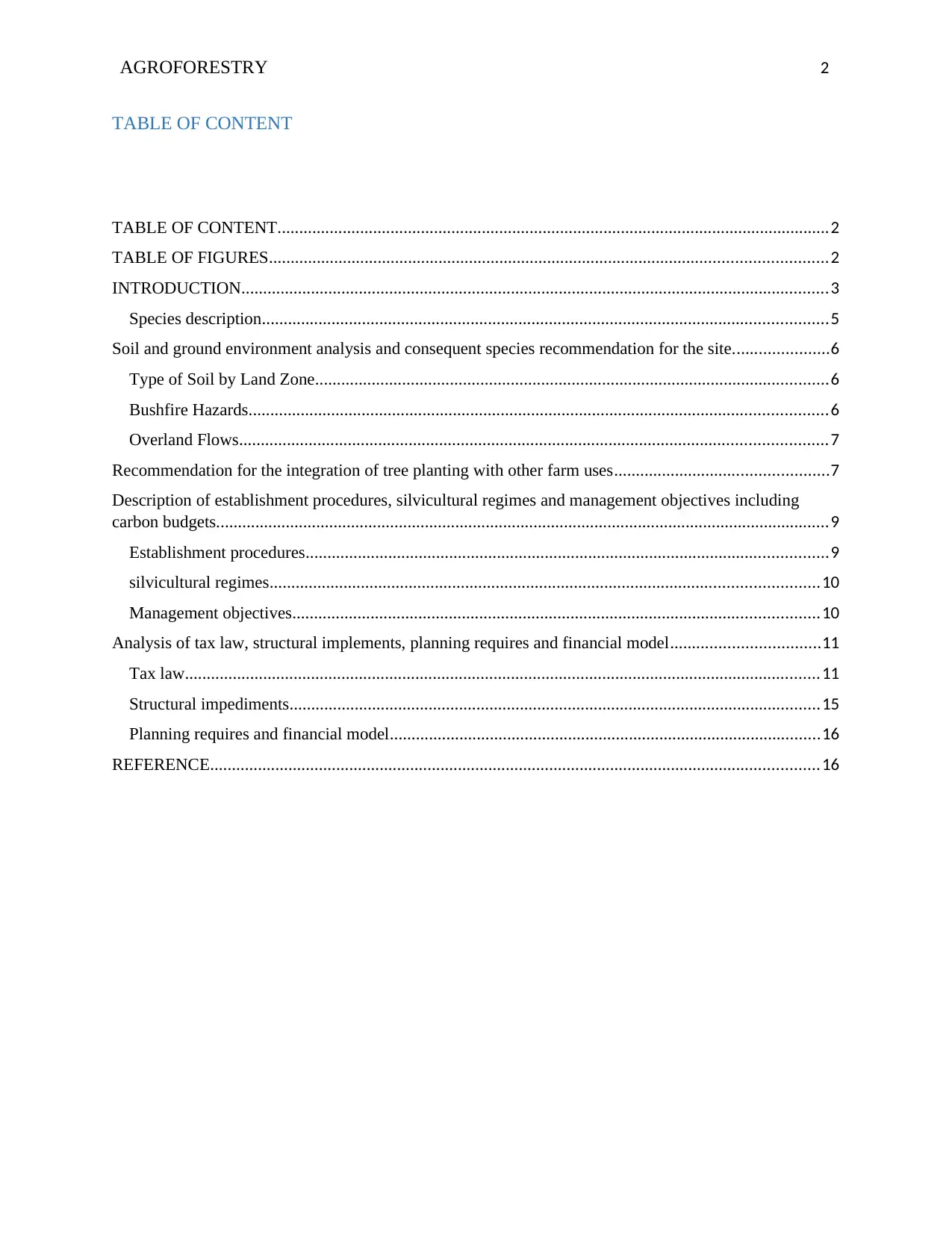
AGROFORESTRY 2
TABLE OF CONTENT
TABLE OF CONTENT...............................................................................................................................2
TABLE OF FIGURES................................................................................................................................2
INTRODUCTION.......................................................................................................................................3
Species description..................................................................................................................................5
Soil and ground environment analysis and consequent species recommendation for the site......................6
Type of Soil by Land Zone......................................................................................................................6
Bushfire Hazards.....................................................................................................................................6
Overland Flows.......................................................................................................................................7
Recommendation for the integration of tree planting with other farm uses.................................................7
Description of establishment procedures, silvicultural regimes and management objectives including
carbon budgets.............................................................................................................................................9
Establishment procedures........................................................................................................................9
silvicultural regimes..............................................................................................................................10
Management objectives.........................................................................................................................10
Analysis of tax law, structural implements, planning requires and financial model..................................11
Tax law..................................................................................................................................................11
Structural impediments..........................................................................................................................15
Planning requires and financial model...................................................................................................16
REFERENCE............................................................................................................................................16
TABLE OF CONTENT
TABLE OF CONTENT...............................................................................................................................2
TABLE OF FIGURES................................................................................................................................2
INTRODUCTION.......................................................................................................................................3
Species description..................................................................................................................................5
Soil and ground environment analysis and consequent species recommendation for the site......................6
Type of Soil by Land Zone......................................................................................................................6
Bushfire Hazards.....................................................................................................................................6
Overland Flows.......................................................................................................................................7
Recommendation for the integration of tree planting with other farm uses.................................................7
Description of establishment procedures, silvicultural regimes and management objectives including
carbon budgets.............................................................................................................................................9
Establishment procedures........................................................................................................................9
silvicultural regimes..............................................................................................................................10
Management objectives.........................................................................................................................10
Analysis of tax law, structural implements, planning requires and financial model..................................11
Tax law..................................................................................................................................................11
Structural impediments..........................................................................................................................15
Planning requires and financial model...................................................................................................16
REFERENCE............................................................................................................................................16
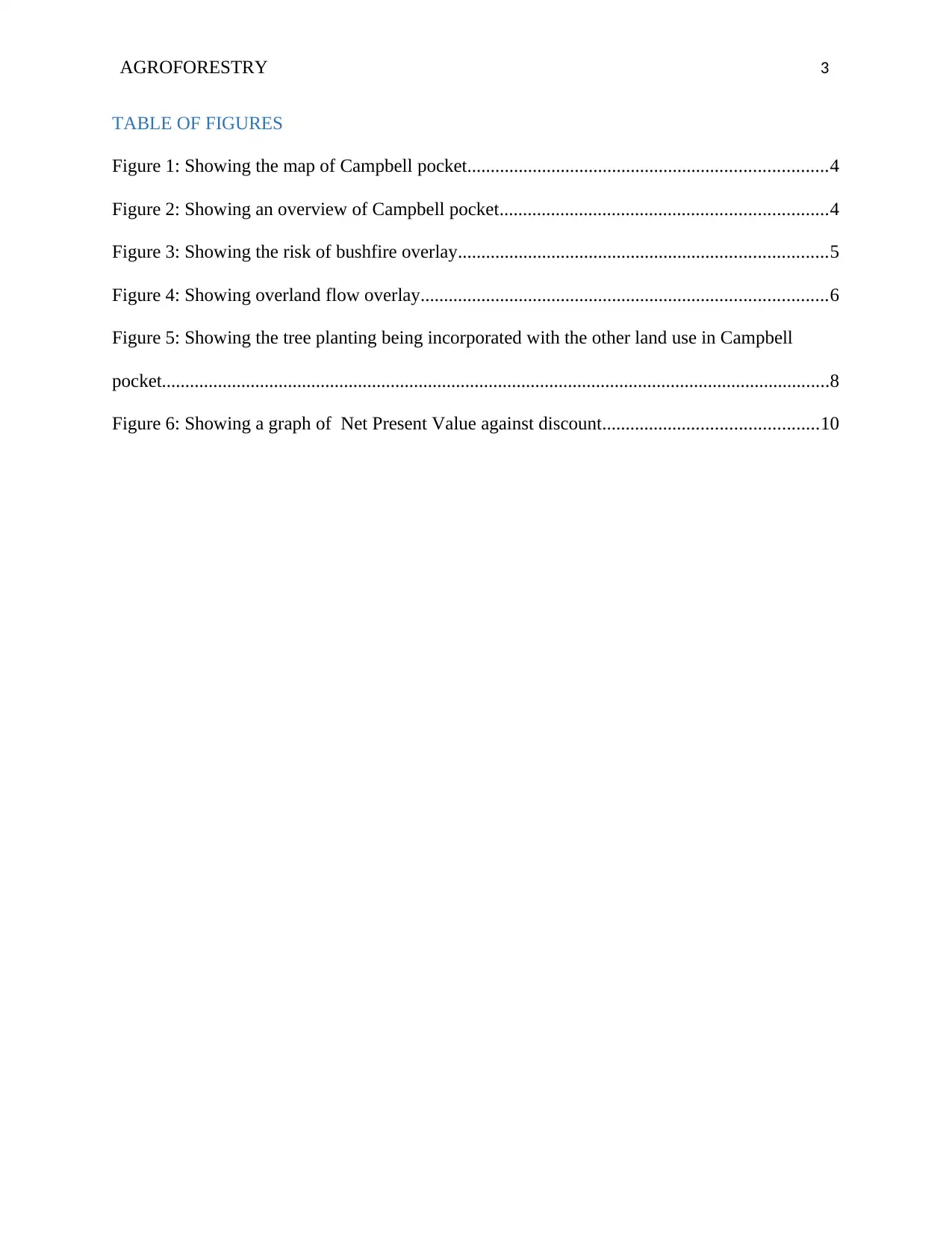
AGROFORESTRY 3
TABLE OF FIGURES
Figure 1: Showing the map of Campbell pocket.............................................................................4
Figure 2: Showing an overview of Campbell pocket......................................................................4
Figure 3: Showing the risk of bushfire overlay...............................................................................5
Figure 4: Showing overland flow overlay.......................................................................................6
Figure 5: Showing the tree planting being incorporated with the other land use in Campbell
pocket...............................................................................................................................................8
Figure 6: Showing a graph of Net Present Value against discount..............................................10
TABLE OF FIGURES
Figure 1: Showing the map of Campbell pocket.............................................................................4
Figure 2: Showing an overview of Campbell pocket......................................................................4
Figure 3: Showing the risk of bushfire overlay...............................................................................5
Figure 4: Showing overland flow overlay.......................................................................................6
Figure 5: Showing the tree planting being incorporated with the other land use in Campbell
pocket...............................................................................................................................................8
Figure 6: Showing a graph of Net Present Value against discount..............................................10
⊘ This is a preview!⊘
Do you want full access?
Subscribe today to unlock all pages.

Trusted by 1+ million students worldwide
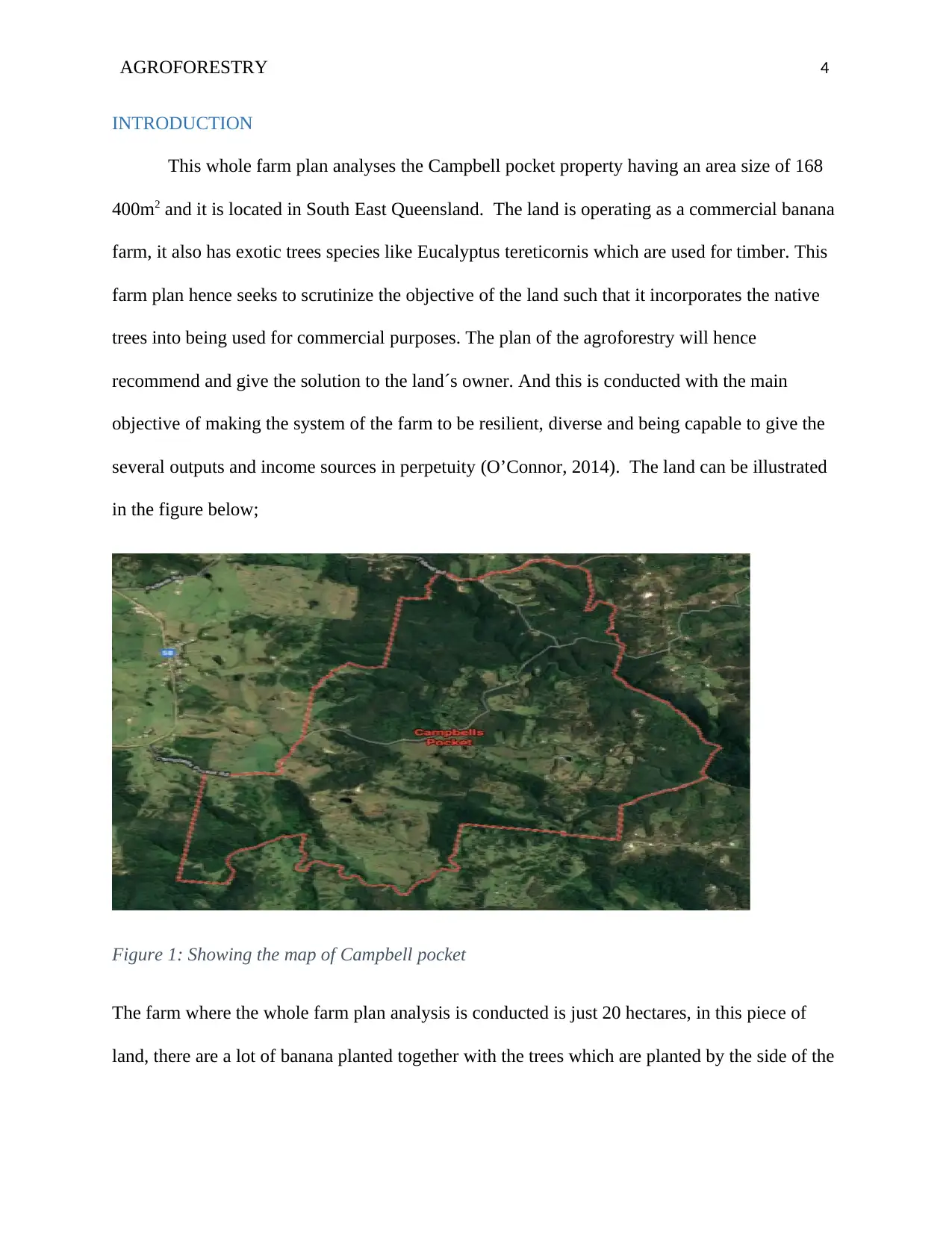
AGROFORESTRY 4
INTRODUCTION
This whole farm plan analyses the Campbell pocket property having an area size of 168
400m2 and it is located in South East Queensland. The land is operating as a commercial banana
farm, it also has exotic trees species like Eucalyptus tereticornis which are used for timber. This
farm plan hence seeks to scrutinize the objective of the land such that it incorporates the native
trees into being used for commercial purposes. The plan of the agroforestry will hence
recommend and give the solution to the land´s owner. And this is conducted with the main
objective of making the system of the farm to be resilient, diverse and being capable to give the
several outputs and income sources in perpetuity (O’Connor, 2014). The land can be illustrated
in the figure below;
Figure 1: Showing the map of Campbell pocket
The farm where the whole farm plan analysis is conducted is just 20 hectares, in this piece of
land, there are a lot of banana planted together with the trees which are planted by the side of the
INTRODUCTION
This whole farm plan analyses the Campbell pocket property having an area size of 168
400m2 and it is located in South East Queensland. The land is operating as a commercial banana
farm, it also has exotic trees species like Eucalyptus tereticornis which are used for timber. This
farm plan hence seeks to scrutinize the objective of the land such that it incorporates the native
trees into being used for commercial purposes. The plan of the agroforestry will hence
recommend and give the solution to the land´s owner. And this is conducted with the main
objective of making the system of the farm to be resilient, diverse and being capable to give the
several outputs and income sources in perpetuity (O’Connor, 2014). The land can be illustrated
in the figure below;
Figure 1: Showing the map of Campbell pocket
The farm where the whole farm plan analysis is conducted is just 20 hectares, in this piece of
land, there are a lot of banana planted together with the trees which are planted by the side of the
Paraphrase This Document
Need a fresh take? Get an instant paraphrase of this document with our AI Paraphraser
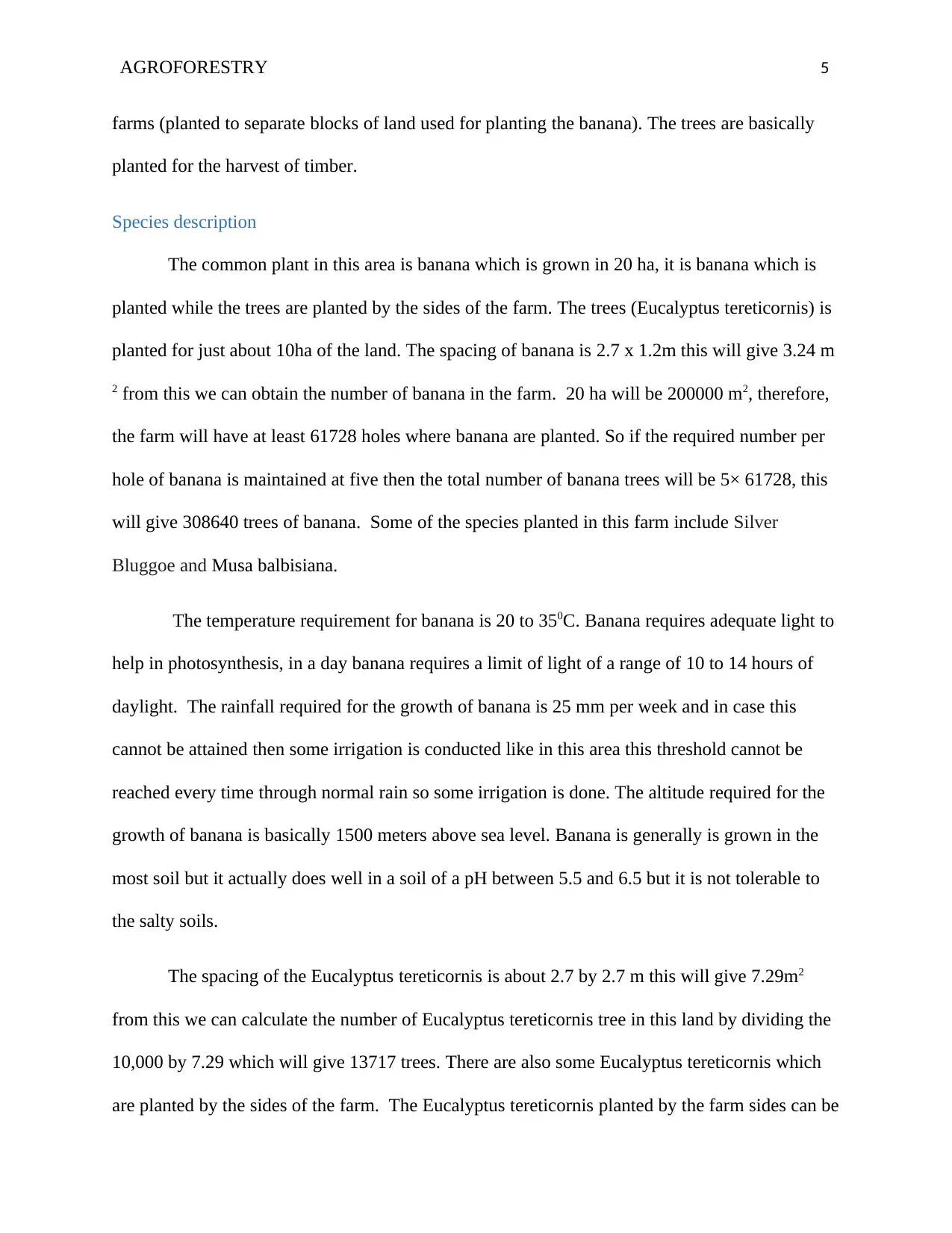
AGROFORESTRY 5
farms (planted to separate blocks of land used for planting the banana). The trees are basically
planted for the harvest of timber.
Species description
The common plant in this area is banana which is grown in 20 ha, it is banana which is
planted while the trees are planted by the sides of the farm. The trees (Eucalyptus tereticornis) is
planted for just about 10ha of the land. The spacing of banana is 2.7 x 1.2m this will give 3.24 m
2 from this we can obtain the number of banana in the farm. 20 ha will be 200000 m2, therefore,
the farm will have at least 61728 holes where banana are planted. So if the required number per
hole of banana is maintained at five then the total number of banana trees will be 5× 61728, this
will give 308640 trees of banana. Some of the species planted in this farm include Silver
Bluggoe and Musa balbisiana.
The temperature requirement for banana is 20 to 350C. Banana requires adequate light to
help in photosynthesis, in a day banana requires a limit of light of a range of 10 to 14 hours of
daylight. The rainfall required for the growth of banana is 25 mm per week and in case this
cannot be attained then some irrigation is conducted like in this area this threshold cannot be
reached every time through normal rain so some irrigation is done. The altitude required for the
growth of banana is basically 1500 meters above sea level. Banana is generally is grown in the
most soil but it actually does well in a soil of a pH between 5.5 and 6.5 but it is not tolerable to
the salty soils.
The spacing of the Eucalyptus tereticornis is about 2.7 by 2.7 m this will give 7.29m2
from this we can calculate the number of Eucalyptus tereticornis tree in this land by dividing the
10,000 by 7.29 which will give 13717 trees. There are also some Eucalyptus tereticornis which
are planted by the sides of the farm. The Eucalyptus tereticornis planted by the farm sides can be
farms (planted to separate blocks of land used for planting the banana). The trees are basically
planted for the harvest of timber.
Species description
The common plant in this area is banana which is grown in 20 ha, it is banana which is
planted while the trees are planted by the sides of the farm. The trees (Eucalyptus tereticornis) is
planted for just about 10ha of the land. The spacing of banana is 2.7 x 1.2m this will give 3.24 m
2 from this we can obtain the number of banana in the farm. 20 ha will be 200000 m2, therefore,
the farm will have at least 61728 holes where banana are planted. So if the required number per
hole of banana is maintained at five then the total number of banana trees will be 5× 61728, this
will give 308640 trees of banana. Some of the species planted in this farm include Silver
Bluggoe and Musa balbisiana.
The temperature requirement for banana is 20 to 350C. Banana requires adequate light to
help in photosynthesis, in a day banana requires a limit of light of a range of 10 to 14 hours of
daylight. The rainfall required for the growth of banana is 25 mm per week and in case this
cannot be attained then some irrigation is conducted like in this area this threshold cannot be
reached every time through normal rain so some irrigation is done. The altitude required for the
growth of banana is basically 1500 meters above sea level. Banana is generally is grown in the
most soil but it actually does well in a soil of a pH between 5.5 and 6.5 but it is not tolerable to
the salty soils.
The spacing of the Eucalyptus tereticornis is about 2.7 by 2.7 m this will give 7.29m2
from this we can calculate the number of Eucalyptus tereticornis tree in this land by dividing the
10,000 by 7.29 which will give 13717 trees. There are also some Eucalyptus tereticornis which
are planted by the sides of the farm. The Eucalyptus tereticornis planted by the farm sides can be
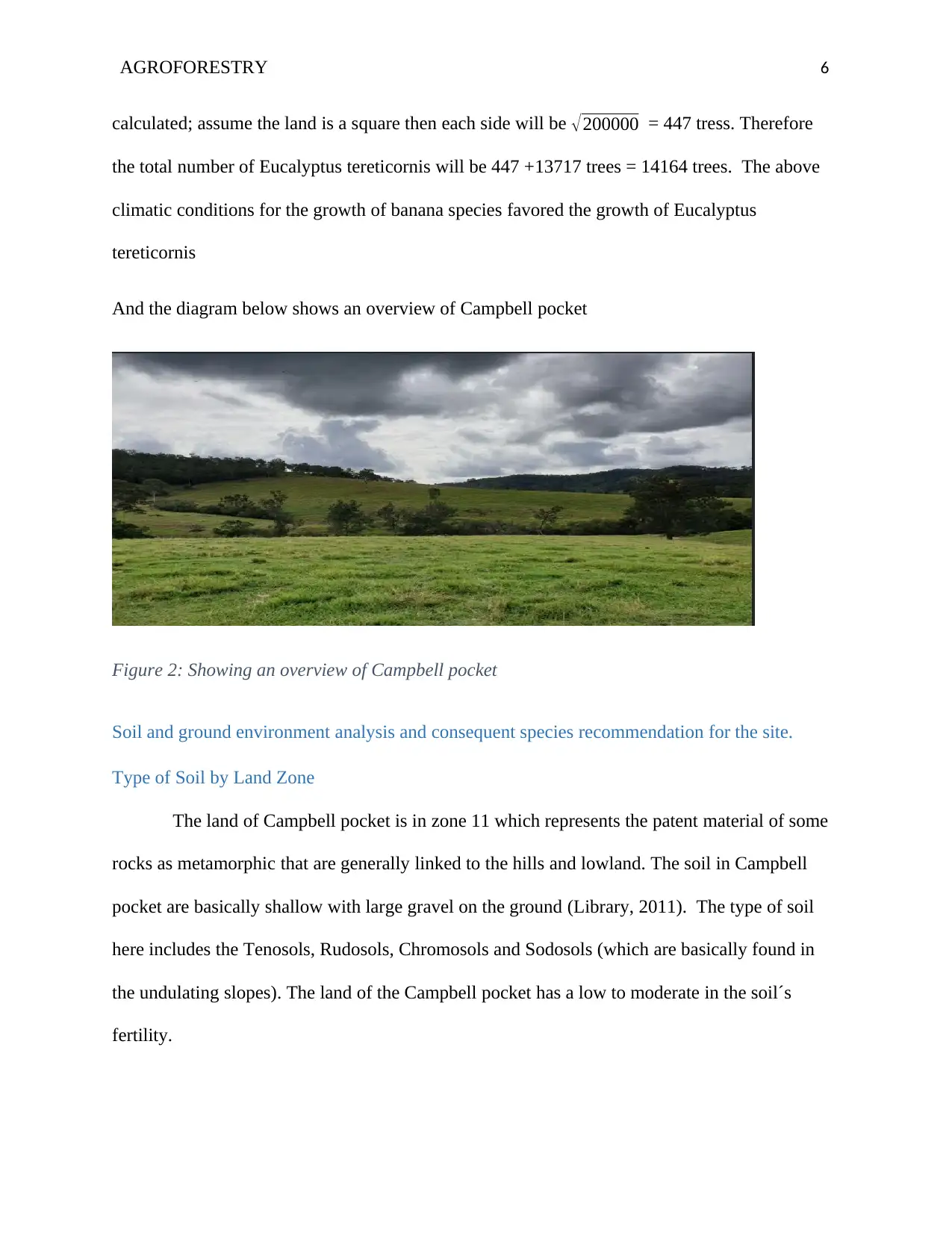
AGROFORESTRY 6
calculated; assume the land is a square then each side will be √ 200000 = 447 tress. Therefore
the total number of Eucalyptus tereticornis will be 447 +13717 trees = 14164 trees. The above
climatic conditions for the growth of banana species favored the growth of Eucalyptus
tereticornis
And the diagram below shows an overview of Campbell pocket
Figure 2: Showing an overview of Campbell pocket
Soil and ground environment analysis and consequent species recommendation for the site.
Type of Soil by Land Zone
The land of Campbell pocket is in zone 11 which represents the patent material of some
rocks as metamorphic that are generally linked to the hills and lowland. The soil in Campbell
pocket are basically shallow with large gravel on the ground (Library, 2011). The type of soil
here includes the Tenosols, Rudosols, Chromosols and Sodosols (which are basically found in
the undulating slopes). The land of the Campbell pocket has a low to moderate in the soil´s
fertility.
calculated; assume the land is a square then each side will be √ 200000 = 447 tress. Therefore
the total number of Eucalyptus tereticornis will be 447 +13717 trees = 14164 trees. The above
climatic conditions for the growth of banana species favored the growth of Eucalyptus
tereticornis
And the diagram below shows an overview of Campbell pocket
Figure 2: Showing an overview of Campbell pocket
Soil and ground environment analysis and consequent species recommendation for the site.
Type of Soil by Land Zone
The land of Campbell pocket is in zone 11 which represents the patent material of some
rocks as metamorphic that are generally linked to the hills and lowland. The soil in Campbell
pocket are basically shallow with large gravel on the ground (Library, 2011). The type of soil
here includes the Tenosols, Rudosols, Chromosols and Sodosols (which are basically found in
the undulating slopes). The land of the Campbell pocket has a low to moderate in the soil´s
fertility.
⊘ This is a preview!⊘
Do you want full access?
Subscribe today to unlock all pages.

Trusted by 1+ million students worldwide
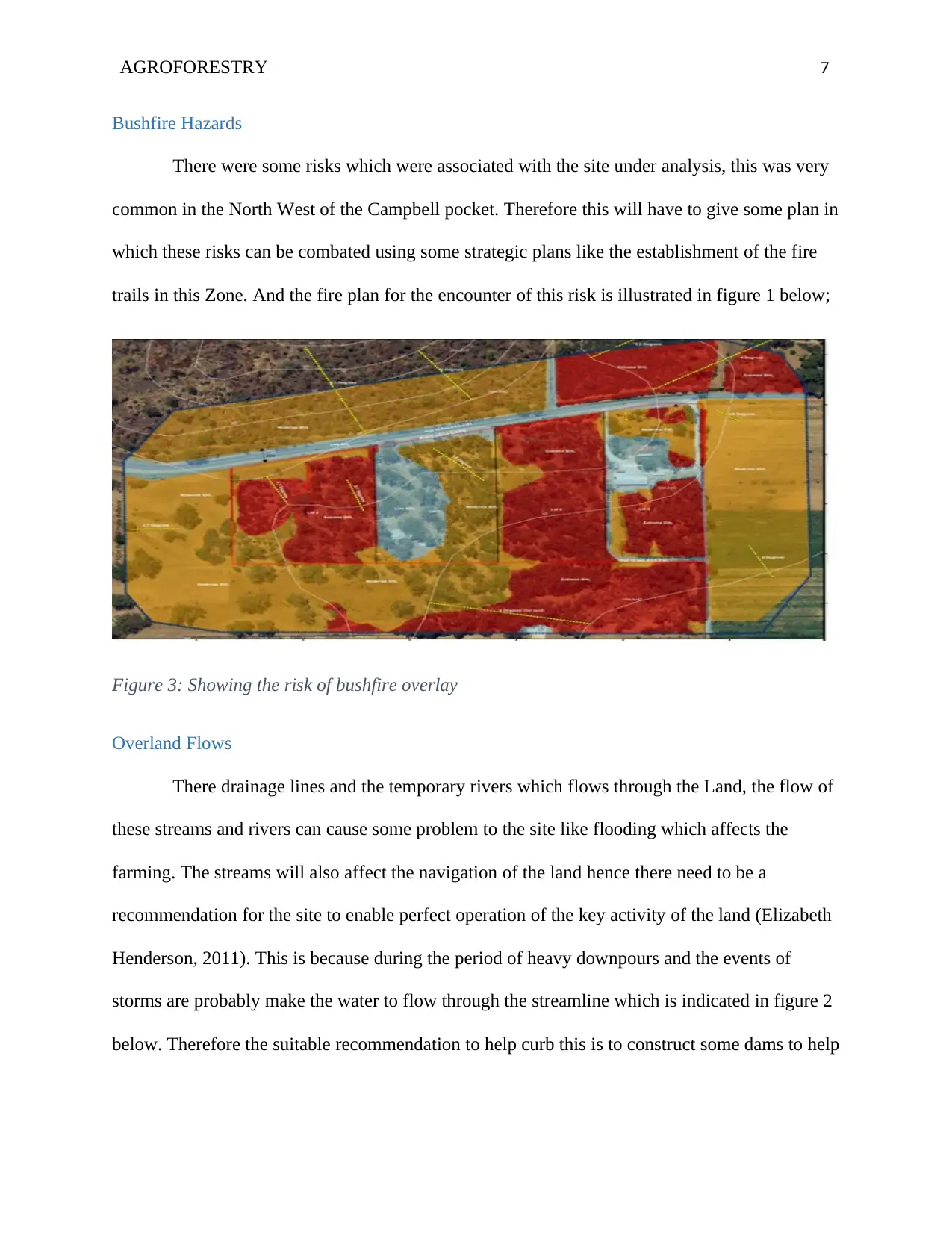
AGROFORESTRY 7
Bushfire Hazards
There were some risks which were associated with the site under analysis, this was very
common in the North West of the Campbell pocket. Therefore this will have to give some plan in
which these risks can be combated using some strategic plans like the establishment of the fire
trails in this Zone. And the fire plan for the encounter of this risk is illustrated in figure 1 below;
Figure 3: Showing the risk of bushfire overlay
Overland Flows
There drainage lines and the temporary rivers which flows through the Land, the flow of
these streams and rivers can cause some problem to the site like flooding which affects the
farming. The streams will also affect the navigation of the land hence there need to be a
recommendation for the site to enable perfect operation of the key activity of the land (Elizabeth
Henderson, 2011). This is because during the period of heavy downpours and the events of
storms are probably make the water to flow through the streamline which is indicated in figure 2
below. Therefore the suitable recommendation to help curb this is to construct some dams to help
Bushfire Hazards
There were some risks which were associated with the site under analysis, this was very
common in the North West of the Campbell pocket. Therefore this will have to give some plan in
which these risks can be combated using some strategic plans like the establishment of the fire
trails in this Zone. And the fire plan for the encounter of this risk is illustrated in figure 1 below;
Figure 3: Showing the risk of bushfire overlay
Overland Flows
There drainage lines and the temporary rivers which flows through the Land, the flow of
these streams and rivers can cause some problem to the site like flooding which affects the
farming. The streams will also affect the navigation of the land hence there need to be a
recommendation for the site to enable perfect operation of the key activity of the land (Elizabeth
Henderson, 2011). This is because during the period of heavy downpours and the events of
storms are probably make the water to flow through the streamline which is indicated in figure 2
below. Therefore the suitable recommendation to help curb this is to construct some dams to help
Paraphrase This Document
Need a fresh take? Get an instant paraphrase of this document with our AI Paraphraser
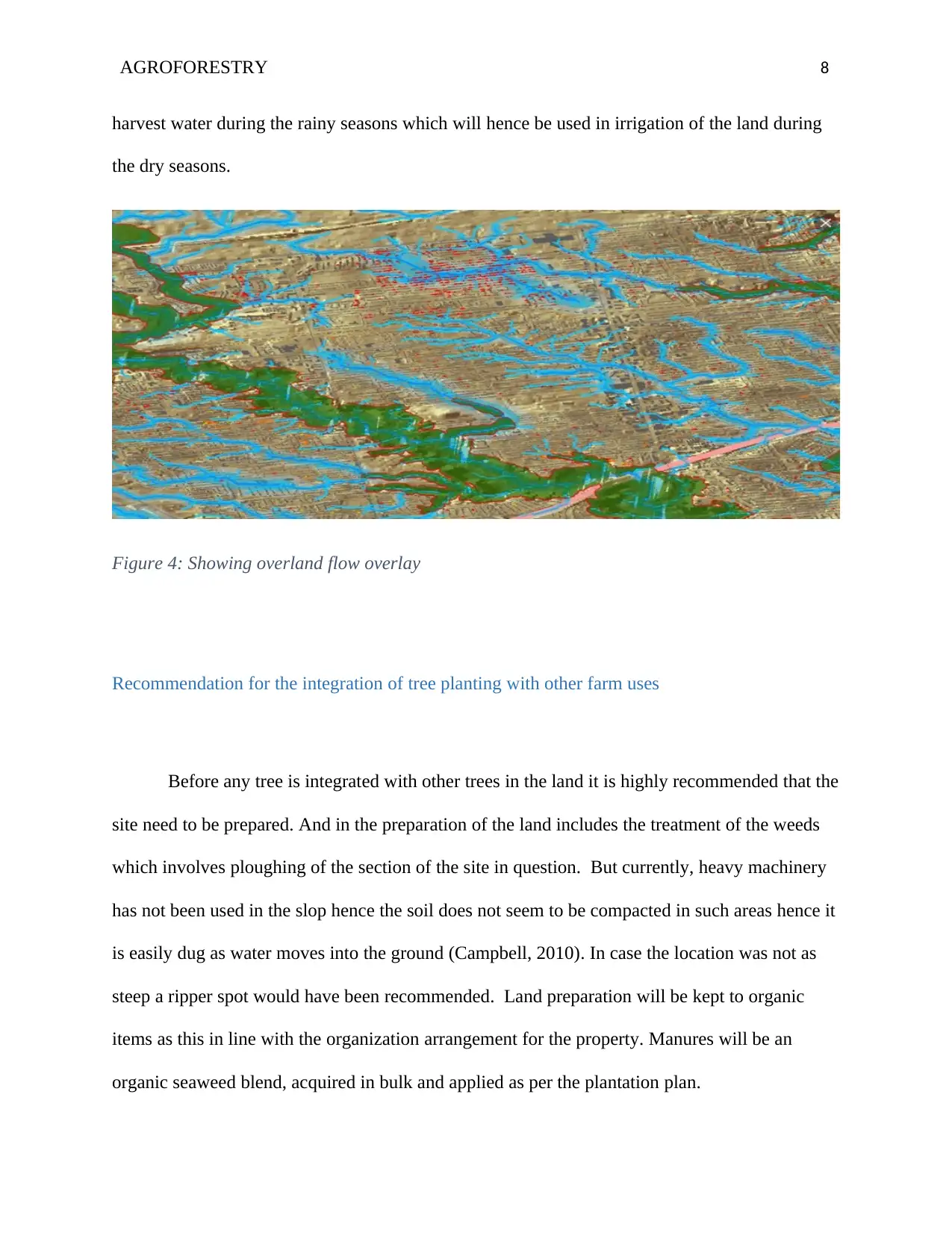
AGROFORESTRY 8
harvest water during the rainy seasons which will hence be used in irrigation of the land during
the dry seasons.
Figure 4: Showing overland flow overlay
Recommendation for the integration of tree planting with other farm uses
Before any tree is integrated with other trees in the land it is highly recommended that the
site need to be prepared. And in the preparation of the land includes the treatment of the weeds
which involves ploughing of the section of the site in question. But currently, heavy machinery
has not been used in the slop hence the soil does not seem to be compacted in such areas hence it
is easily dug as water moves into the ground (Campbell, 2010). In case the location was not as
steep a ripper spot would have been recommended. Land preparation will be kept to organic
items as this in line with the organization arrangement for the property. Manures will be an
organic seaweed blend, acquired in bulk and applied as per the plantation plan.
harvest water during the rainy seasons which will hence be used in irrigation of the land during
the dry seasons.
Figure 4: Showing overland flow overlay
Recommendation for the integration of tree planting with other farm uses
Before any tree is integrated with other trees in the land it is highly recommended that the
site need to be prepared. And in the preparation of the land includes the treatment of the weeds
which involves ploughing of the section of the site in question. But currently, heavy machinery
has not been used in the slop hence the soil does not seem to be compacted in such areas hence it
is easily dug as water moves into the ground (Campbell, 2010). In case the location was not as
steep a ripper spot would have been recommended. Land preparation will be kept to organic
items as this in line with the organization arrangement for the property. Manures will be an
organic seaweed blend, acquired in bulk and applied as per the plantation plan.
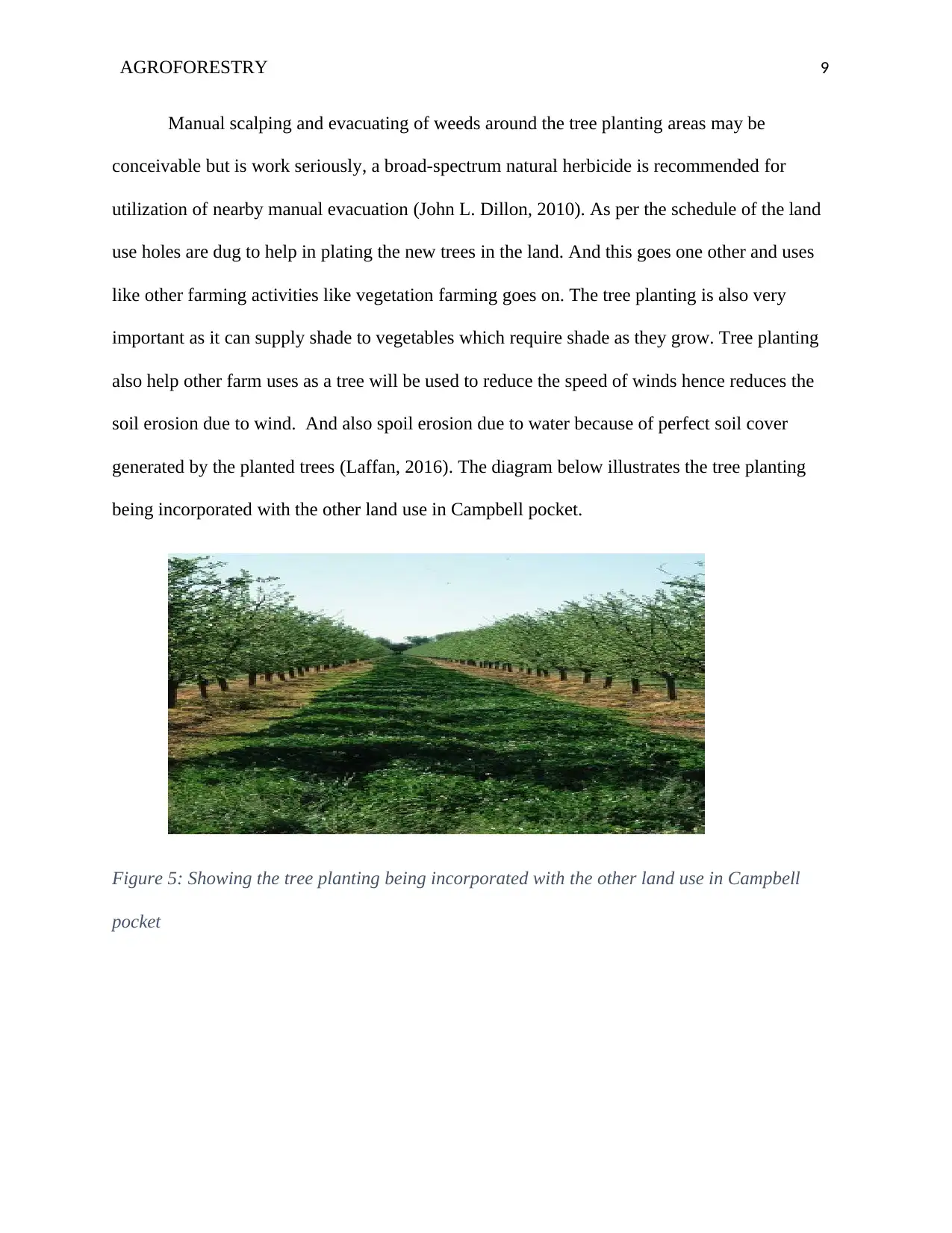
AGROFORESTRY 9
Manual scalping and evacuating of weeds around the tree planting areas may be
conceivable but is work seriously, a broad-spectrum natural herbicide is recommended for
utilization of nearby manual evacuation (John L. Dillon, 2010). As per the schedule of the land
use holes are dug to help in plating the new trees in the land. And this goes one other and uses
like other farming activities like vegetation farming goes on. The tree planting is also very
important as it can supply shade to vegetables which require shade as they grow. Tree planting
also help other farm uses as a tree will be used to reduce the speed of winds hence reduces the
soil erosion due to wind. And also spoil erosion due to water because of perfect soil cover
generated by the planted trees (Laffan, 2016). The diagram below illustrates the tree planting
being incorporated with the other land use in Campbell pocket.
Figure 5: Showing the tree planting being incorporated with the other land use in Campbell
pocket
Manual scalping and evacuating of weeds around the tree planting areas may be
conceivable but is work seriously, a broad-spectrum natural herbicide is recommended for
utilization of nearby manual evacuation (John L. Dillon, 2010). As per the schedule of the land
use holes are dug to help in plating the new trees in the land. And this goes one other and uses
like other farming activities like vegetation farming goes on. The tree planting is also very
important as it can supply shade to vegetables which require shade as they grow. Tree planting
also help other farm uses as a tree will be used to reduce the speed of winds hence reduces the
soil erosion due to wind. And also spoil erosion due to water because of perfect soil cover
generated by the planted trees (Laffan, 2016). The diagram below illustrates the tree planting
being incorporated with the other land use in Campbell pocket.
Figure 5: Showing the tree planting being incorporated with the other land use in Campbell
⊘ This is a preview!⊘
Do you want full access?
Subscribe today to unlock all pages.

Trusted by 1+ million students worldwide
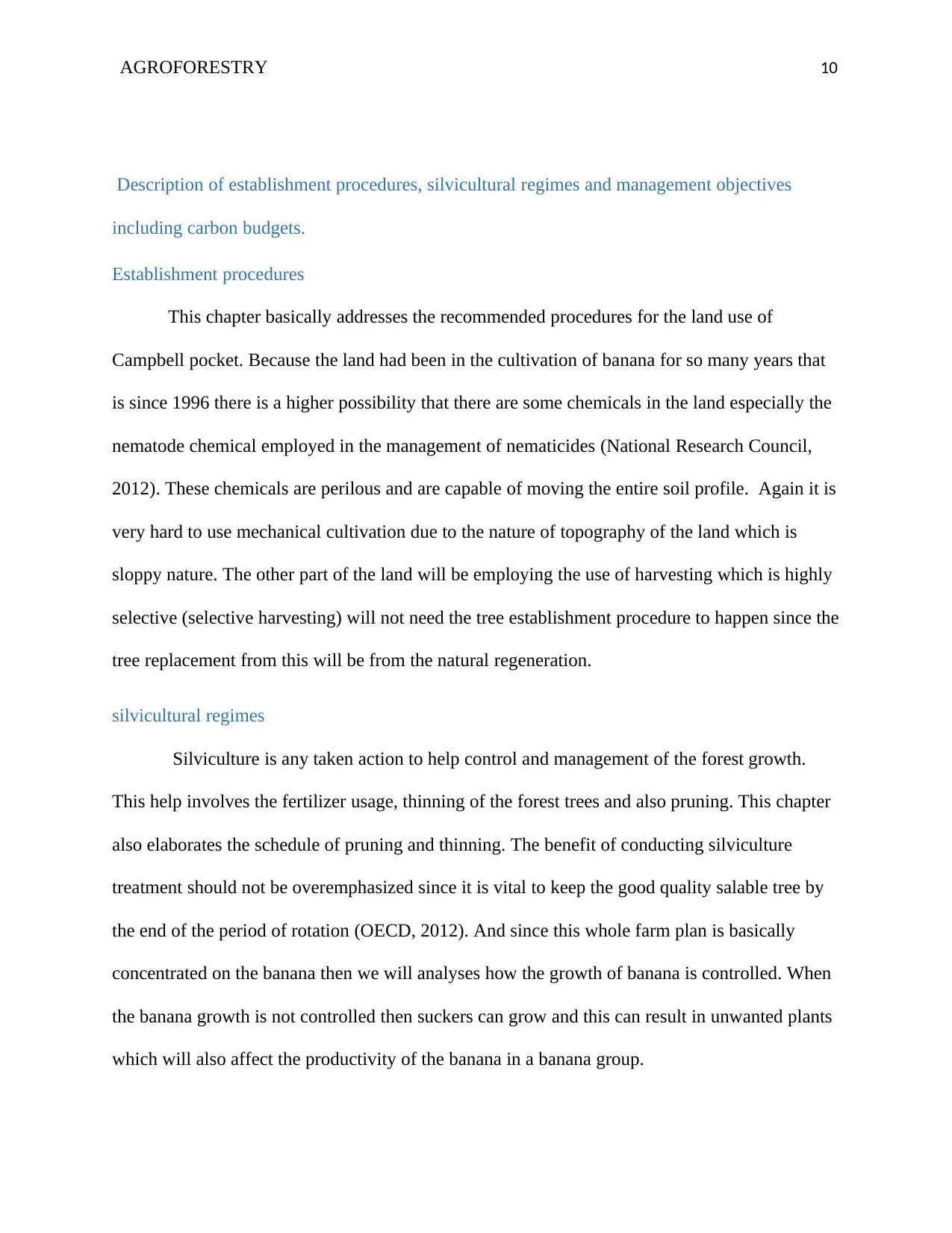
AGROFORESTRY 10
Description of establishment procedures, silvicultural regimes and management objectives
including carbon budgets.
Establishment procedures
This chapter basically addresses the recommended procedures for the land use of
Campbell pocket. Because the land had been in the cultivation of banana for so many years that
is since 1996 there is a higher possibility that there are some chemicals in the land especially the
nematode chemical employed in the management of nematicides (National Research Council,
2012). These chemicals are perilous and are capable of moving the entire soil profile. Again it is
very hard to use mechanical cultivation due to the nature of topography of the land which is
sloppy nature. The other part of the land will be employing the use of harvesting which is highly
selective (selective harvesting) will not need the tree establishment procedure to happen since the
tree replacement from this will be from the natural regeneration.
silvicultural regimes
Silviculture is any taken action to help control and management of the forest growth.
This help involves the fertilizer usage, thinning of the forest trees and also pruning. This chapter
also elaborates the schedule of pruning and thinning. The benefit of conducting silviculture
treatment should not be overemphasized since it is vital to keep the good quality salable tree by
the end of the period of rotation (OECD, 2012). And since this whole farm plan is basically
concentrated on the banana then we will analyses how the growth of banana is controlled. When
the banana growth is not controlled then suckers can grow and this can result in unwanted plants
which will also affect the productivity of the banana in a banana group.
Description of establishment procedures, silvicultural regimes and management objectives
including carbon budgets.
Establishment procedures
This chapter basically addresses the recommended procedures for the land use of
Campbell pocket. Because the land had been in the cultivation of banana for so many years that
is since 1996 there is a higher possibility that there are some chemicals in the land especially the
nematode chemical employed in the management of nematicides (National Research Council,
2012). These chemicals are perilous and are capable of moving the entire soil profile. Again it is
very hard to use mechanical cultivation due to the nature of topography of the land which is
sloppy nature. The other part of the land will be employing the use of harvesting which is highly
selective (selective harvesting) will not need the tree establishment procedure to happen since the
tree replacement from this will be from the natural regeneration.
silvicultural regimes
Silviculture is any taken action to help control and management of the forest growth.
This help involves the fertilizer usage, thinning of the forest trees and also pruning. This chapter
also elaborates the schedule of pruning and thinning. The benefit of conducting silviculture
treatment should not be overemphasized since it is vital to keep the good quality salable tree by
the end of the period of rotation (OECD, 2012). And since this whole farm plan is basically
concentrated on the banana then we will analyses how the growth of banana is controlled. When
the banana growth is not controlled then suckers can grow and this can result in unwanted plants
which will also affect the productivity of the banana in a banana group.
Paraphrase This Document
Need a fresh take? Get an instant paraphrase of this document with our AI Paraphraser
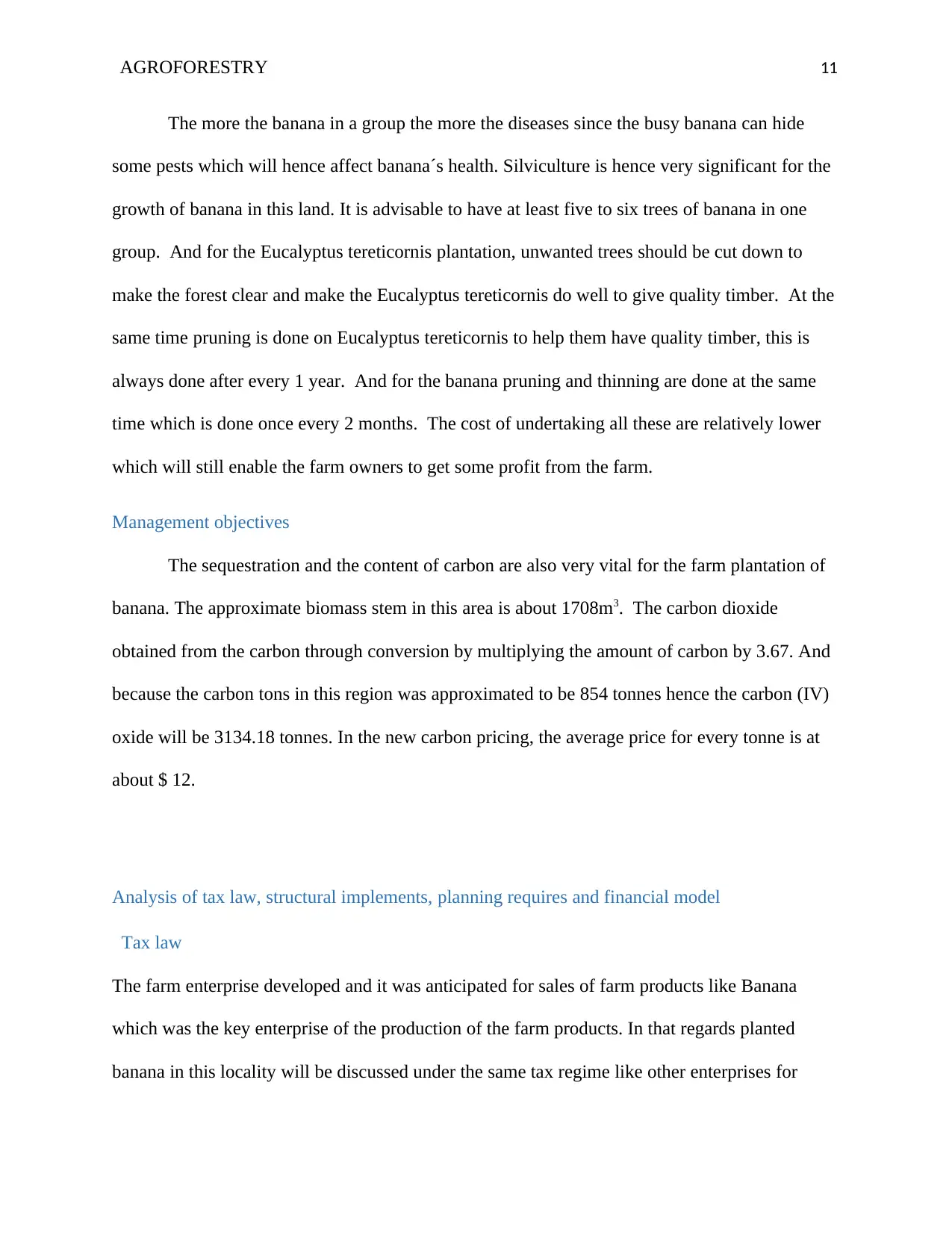
AGROFORESTRY 11
The more the banana in a group the more the diseases since the busy banana can hide
some pests which will hence affect banana´s health. Silviculture is hence very significant for the
growth of banana in this land. It is advisable to have at least five to six trees of banana in one
group. And for the Eucalyptus tereticornis plantation, unwanted trees should be cut down to
make the forest clear and make the Eucalyptus tereticornis do well to give quality timber. At the
same time pruning is done on Eucalyptus tereticornis to help them have quality timber, this is
always done after every 1 year. And for the banana pruning and thinning are done at the same
time which is done once every 2 months. The cost of undertaking all these are relatively lower
which will still enable the farm owners to get some profit from the farm.
Management objectives
The sequestration and the content of carbon are also very vital for the farm plantation of
banana. The approximate biomass stem in this area is about 1708m3. The carbon dioxide
obtained from the carbon through conversion by multiplying the amount of carbon by 3.67. And
because the carbon tons in this region was approximated to be 854 tonnes hence the carbon (IV)
oxide will be 3134.18 tonnes. In the new carbon pricing, the average price for every tonne is at
about $ 12.
Analysis of tax law, structural implements, planning requires and financial model
Tax law
The farm enterprise developed and it was anticipated for sales of farm products like Banana
which was the key enterprise of the production of the farm products. In that regards planted
banana in this locality will be discussed under the same tax regime like other enterprises for
The more the banana in a group the more the diseases since the busy banana can hide
some pests which will hence affect banana´s health. Silviculture is hence very significant for the
growth of banana in this land. It is advisable to have at least five to six trees of banana in one
group. And for the Eucalyptus tereticornis plantation, unwanted trees should be cut down to
make the forest clear and make the Eucalyptus tereticornis do well to give quality timber. At the
same time pruning is done on Eucalyptus tereticornis to help them have quality timber, this is
always done after every 1 year. And for the banana pruning and thinning are done at the same
time which is done once every 2 months. The cost of undertaking all these are relatively lower
which will still enable the farm owners to get some profit from the farm.
Management objectives
The sequestration and the content of carbon are also very vital for the farm plantation of
banana. The approximate biomass stem in this area is about 1708m3. The carbon dioxide
obtained from the carbon through conversion by multiplying the amount of carbon by 3.67. And
because the carbon tons in this region was approximated to be 854 tonnes hence the carbon (IV)
oxide will be 3134.18 tonnes. In the new carbon pricing, the average price for every tonne is at
about $ 12.
Analysis of tax law, structural implements, planning requires and financial model
Tax law
The farm enterprise developed and it was anticipated for sales of farm products like Banana
which was the key enterprise of the production of the farm products. In that regards planted
banana in this locality will be discussed under the same tax regime like other enterprises for
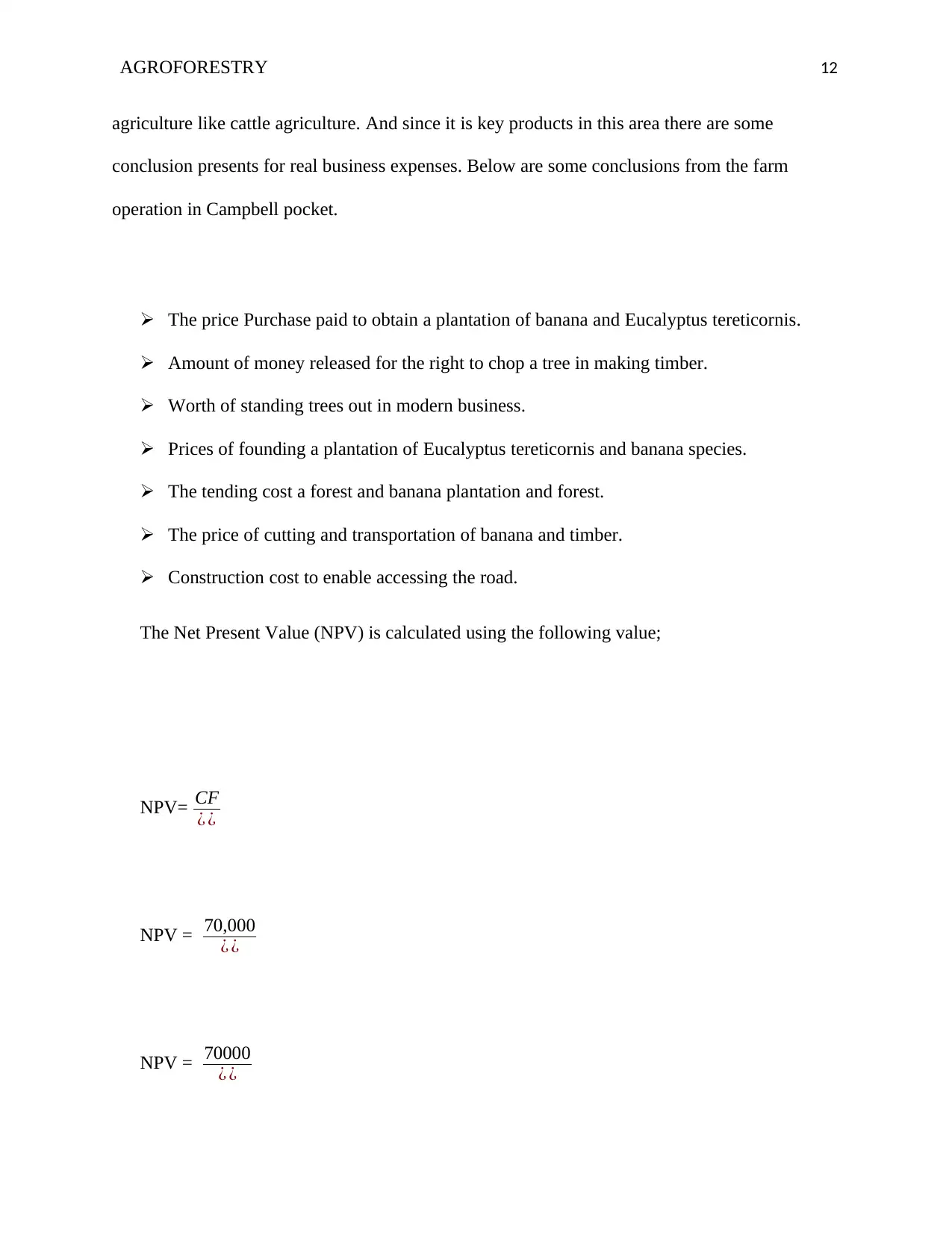
AGROFORESTRY 12
agriculture like cattle agriculture. And since it is key products in this area there are some
conclusion presents for real business expenses. Below are some conclusions from the farm
operation in Campbell pocket.
The price Purchase paid to obtain a plantation of banana and Eucalyptus tereticornis.
Amount of money released for the right to chop a tree in making timber.
Worth of standing trees out in modern business.
Prices of founding a plantation of Eucalyptus tereticornis and banana species.
The tending cost a forest and banana plantation and forest.
The price of cutting and transportation of banana and timber.
Construction cost to enable accessing the road.
The Net Present Value (NPV) is calculated using the following value;
NPV= CF
¿ ¿
NPV = 70,000
¿ ¿
NPV = 70000
¿ ¿
agriculture like cattle agriculture. And since it is key products in this area there are some
conclusion presents for real business expenses. Below are some conclusions from the farm
operation in Campbell pocket.
The price Purchase paid to obtain a plantation of banana and Eucalyptus tereticornis.
Amount of money released for the right to chop a tree in making timber.
Worth of standing trees out in modern business.
Prices of founding a plantation of Eucalyptus tereticornis and banana species.
The tending cost a forest and banana plantation and forest.
The price of cutting and transportation of banana and timber.
Construction cost to enable accessing the road.
The Net Present Value (NPV) is calculated using the following value;
NPV= CF
¿ ¿
NPV = 70,000
¿ ¿
NPV = 70000
¿ ¿
⊘ This is a preview!⊘
Do you want full access?
Subscribe today to unlock all pages.

Trusted by 1+ million students worldwide
1 out of 19
Your All-in-One AI-Powered Toolkit for Academic Success.
+13062052269
info@desklib.com
Available 24*7 on WhatsApp / Email
![[object Object]](/_next/static/media/star-bottom.7253800d.svg)
Unlock your academic potential
Copyright © 2020–2025 A2Z Services. All Rights Reserved. Developed and managed by ZUCOL.

